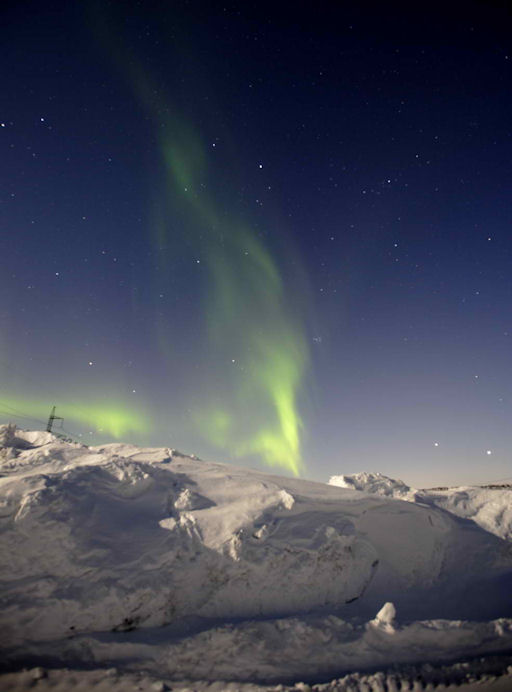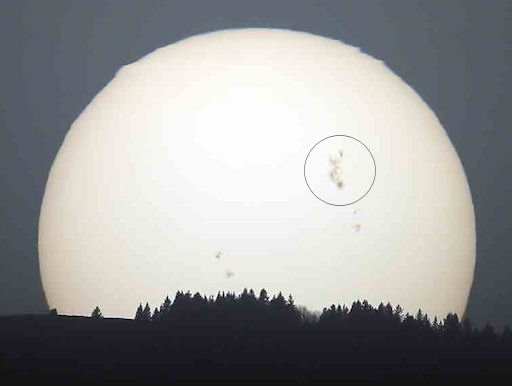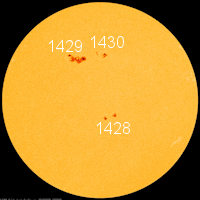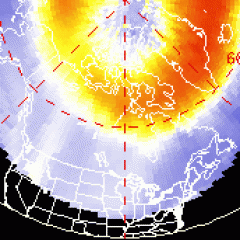~Space Weather Update~ CME IMPACT~~~ [1]
CME IMPACT: A coronal mass ejection (CME) hit Earth's magnetic field on March 8th around 1100 UT. The impact was weaker than expected, sparking only a mild (Kp=5) geomagnetic storm. However, the storm could intensify in the hours ahead depending on electromagnetic conditions in the wake of the CME. High-latitude sky watchers should be alert for auroras. Aurora alerts: text [2], phone [3].
Giovanni Cappelli sends this picture from the tundra east of Murmansk, Russia:
"We were in the tundra waiting for the CME," says Cappelli. "The auroras were better than expected this time. This photo resembled green fire shooting up from the snow "
more images: from Pavel Kantsurov [5] of Norilsk, Russia; from Aleksander Chernucho [6] of Kola peninsula, Russia, Mt. Khibiny; from Chad Blakley [7] of Aurora Sky Station, Abisko National Park, Sweden; from Timo Newton-Syms [8] of Ruka, Finland; from Timo Veijalainen [9] of Sodankylä, Finland;
HUGE SUNSPOT: Active sunspot AR1429 continues to grow. It is now more than seven times wider than Earth, which makes it an easy target for backyard solar telescopes [10]. In fact, yesterday, David Tremblay of Alto, New Mexico, saw it using no telescope at all. All he needed was a dust storm:
"The dust blowing from Tularosa Basin was so dense, we could observe the sun with the naked eye--and there was sunspot AR1429. Wow!" says Tremblay.
The behemoth spot has unleashed four strong flares since it emerged on March 2nd, including the X5-class eruption of March 7th. More could be in the offing. The active region has a "beta-gamma-delta" class magnetic field that harbors energy for additional X-class eruptions. Solar flare alerts: text [2], phone [3].
more images: from Jett Aguilar [12] of Quezon City, Philippines; from James Kevin Ty [13] of Manila, Philippines; from Harald Paleske [14] of Langendorf b. Weißenfels, Germany; from Rogerio Marcon [15] of Campinas SP Brasil; from Monika Landy-Gyebnar [16] of Veszprem, Hungary; from Ron Wayman [17] of Tampa Florida; from John Stetson [18] of Falmouth, Maine; from Robert Lowton [19] of Whaley Bridge, Peak District, United Kingdom; from José Geraldo Mattos [20] of Florianópolis, Jurerê Internacional, Santa Catarina, Brasil; from Matthew Wastell [21] of Brisbane, Australia; from Kiss Csongor [22] of Derecske, Hungary

![]()
Solar wind
speed: 290.8 km/sec
density: 4.6 protons/cm3
explanation [23] | more data [24]
Updated: Today at 1805 UT
![]()
X-ray Solar Flares
6-hr max: C1 1623 UT Mar08
24-hr: C7 0253 UT Mar08
explanation [25] | more data [26]
Updated: Today at: 1800 UT
![]()
![]()
![]()
Daily Sun: 08 Mar 12
![]()
![]()
Big sunspot 1429 poses a continued threat for X-class [28] solar flares. Credit: SDO/HMI
![]()
![]()
![]()
Sunspot number: 102
What is the sunspot number? [29]
Updated 07 Mar 2012
Spotless Days
Current Stretch: 0 days
2012 total: 0 days (0%)
2011 total: 2 days (<1%)
2010 total: 51 days (14%)
2009 total: 260 days (71%)
Since 2004: 821 days
Typical Solar Min: 486 days
Updated 07 Mar 2012
The Radio Sun
10.7 cm flux: 136 sfu
explanation [30] | more data [31]
Updated 07 Mar 2012
![]()
![]()
![]()
Current Auroral Oval:
![]()
Switch to: Europe, USA, New Zealand, Antarctica
Credit: NOAA/POES
![]()
![]()
![]()
Planetary K-index
Now: Kp= 5 storm
24-hr max: Kp= 5 storm
explanation [33] | more data [34]
![]()
Interplanetary Mag. Field
Btotal: 11.1 nT
Bz: 0.9 nT south
explanation [35] | more data [36]
Updated: Today at 1817 UT
![]()
![]()
![]()
Coronal Holes: 08 Mar 12
![]()
![]()
A solar wind stream flowing from this coronal hole could reach Earth as early as March 9-10. Credit: SDO/AIA.
Category:
- Ground Crew Updates [38]




